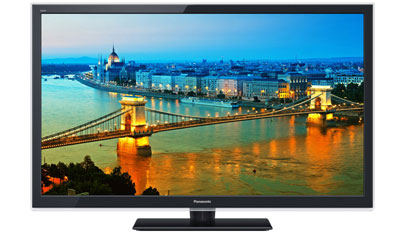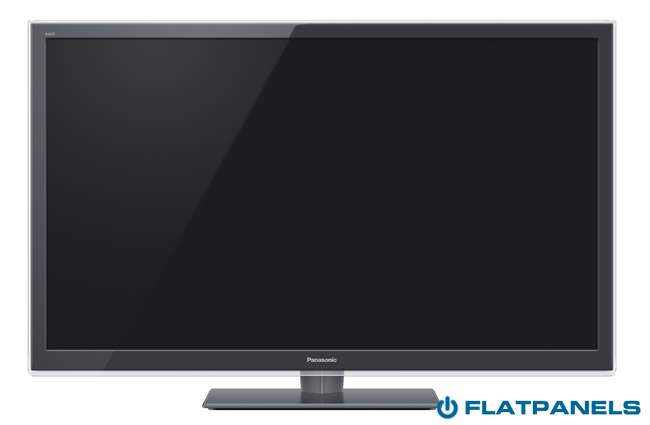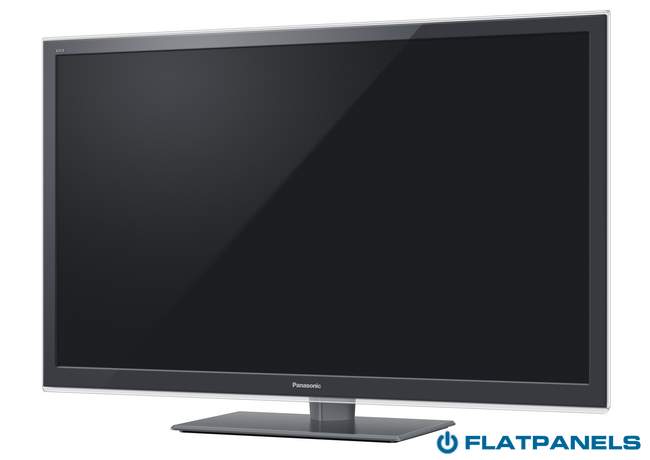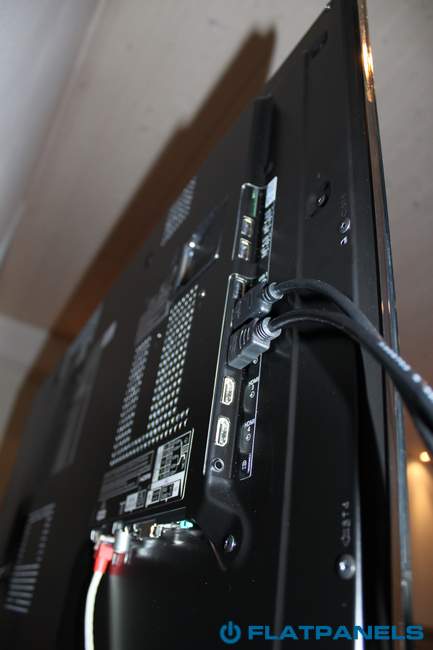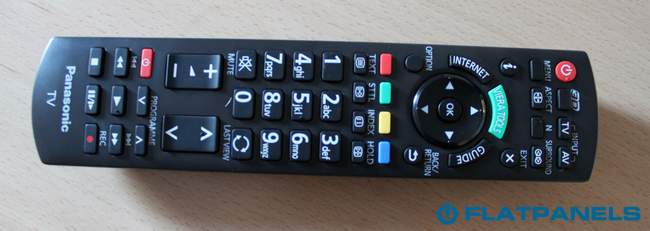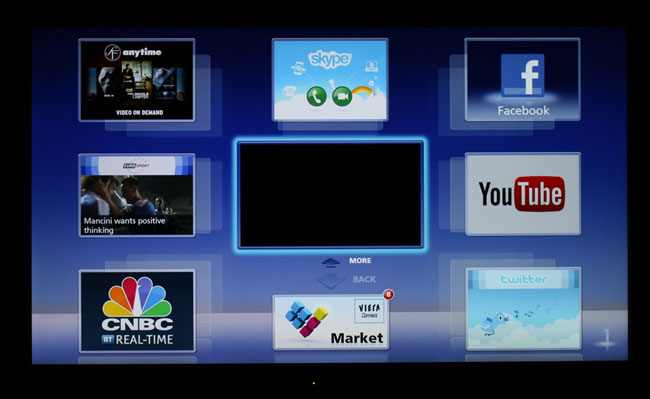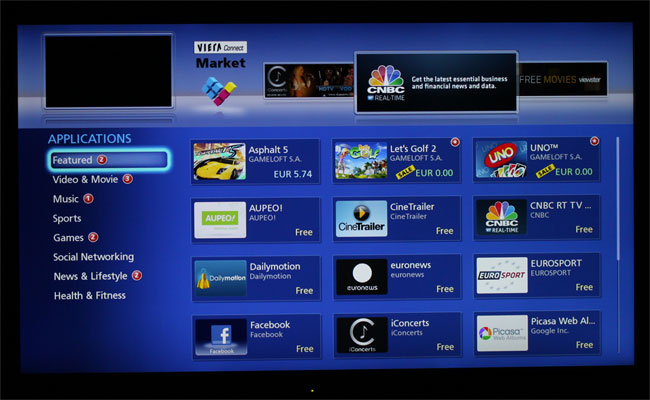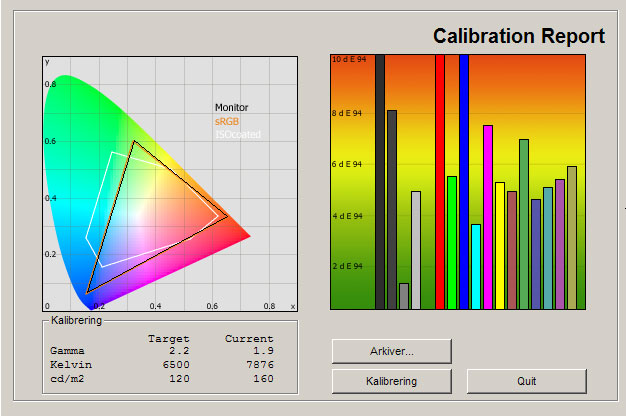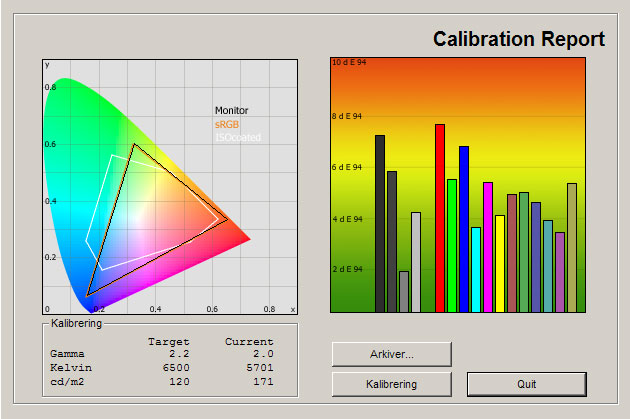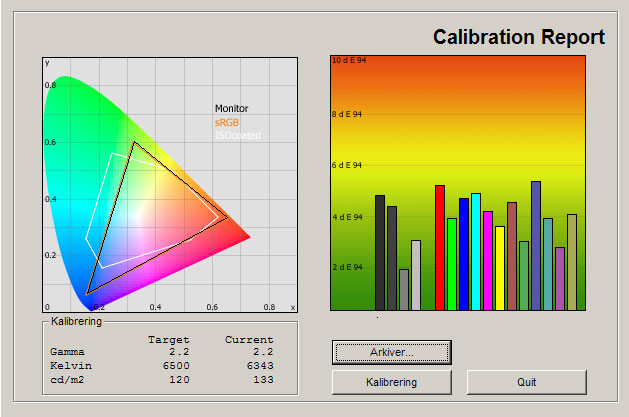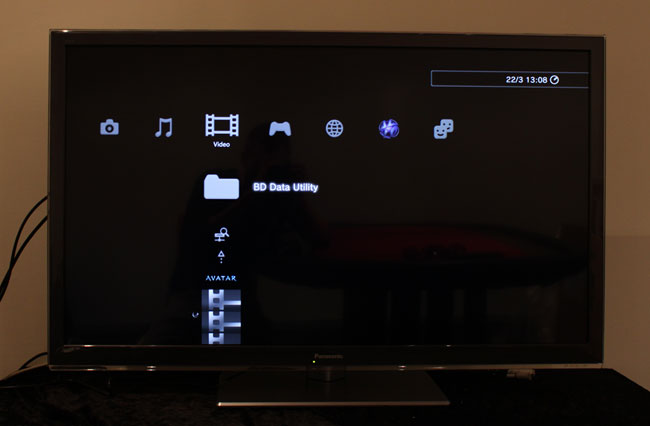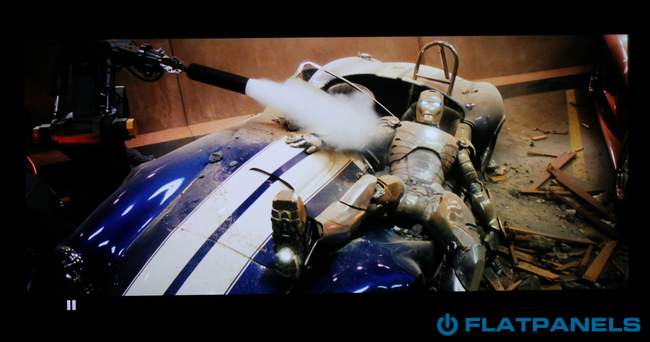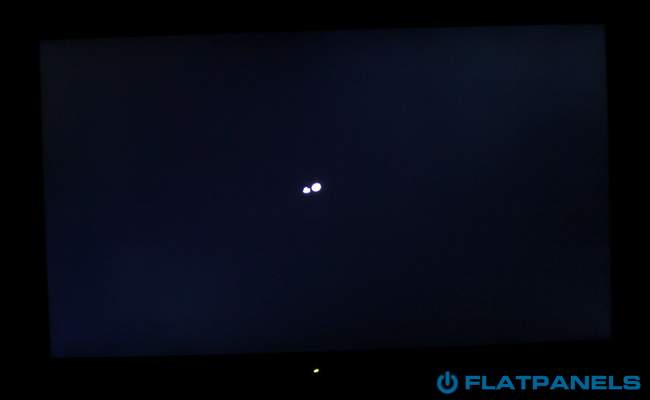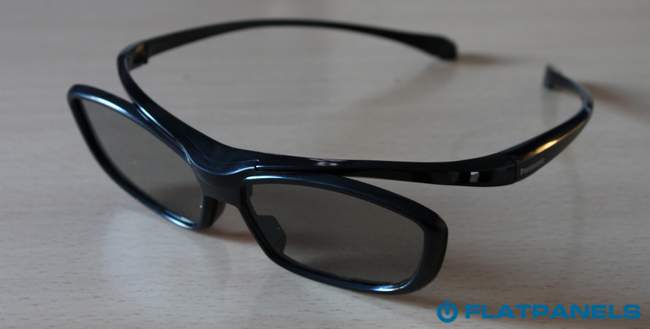Review: Panasonic ET5
TABLE OF CONTENTS Specs - Our first impressions - Test tools - Functionality - Power consumption - Calibration - Picture quality - 3D picture quality - PC & Media Center - Viewing angles - Sound - Conclusion - Debate Panasonic ET5 review
We have received the first TV from Panasonic’s 2012 TV line-up. It is called ET5 and is a mid-range model. ET5 is also the first passive 3D model from Panasonic, and furthermore offers Edge LED, 300/360 Hz backlight scanning and Panasonic’s Smart Viera platform.
Panasonic is hoping to make a splash with their new LED models that will be available in up to 55 inches. But is the ET5 an alternative to TVs in the same price range from the competitors? Has Panasonic managed to replicate some of the picture elements that have made their plasma TVs so popular? And is the passive 3D system worth paying for? FlatpanelsHD will find out in this review.
Panasonic ET5 will be available in US in 42, 47 and 55 inches called TC-L42ET5, TC-L47ET5, and TC-L55ET5, and in Europe in 32, 37, 42, 47 and 55 inches called TX-L32ET5, TX-L37ET5, TX-L42ET5, TX-L47ET5, and TX-L55ET5.
Subscribe to our Newsletter, RSS feed or twitter to receive notice when new reviews are online.
Size: 42" widescreen Resolution: 1920x1080 Response time: - Contrast ratio: - Brightness: - Viewing angles (H/V): 178/178 Panel type: LCD with edge LED Wall mounting: Swivel stand: Dimensions (HxWxD): 47.3cm x 76.4cm x 5.2cm (without stand) Weight 9.5 kg Built-in speakers: Inputs VGA DVI (but possible to convert through HDMI)
Audio (type) (Audio in/out)
S-video Composite Component HDMI (4 inputs, 1 HDMI 1.4)
Outputs Audio (type) (1 output, headphones)
S/PDIF (optical)
Price and retailer:
| US retailer | UK retailer |
 |
Our first impressions
Panasonic ET5 has a black plastic bezel and a rectangular stand. The slim-bezel design from the high-end LED ranges has not found its way to this model but considering what you pay for a TV today, you get a pretty decent-looking set.Panasonic ET5 is still thin due to the edge LED backlighting solution and unlike some of Panasonic’s mid-end plasma TVs, all input connectors are either pointing down or to the side, which is highly convenient if you are planning to wall mount the TV.
Besides that, Panasonic ET5 is a rather discreet-looking TV based on the glossy black look that has dominated for years.
Test tools
Our TV signal is DVB-S (satellite) from Canal Digital and DVB-T (terrestrial). We also have an analogue TV connection. Testing is done with the DVE (digital video essentials) and Peter Finzel test DVD. Testing is also done with DVD, TV, Blu-Ray and Media center/PC.We use our own monitorTest. The software supports some of the traditional test patterns used to evaluate displays as well as some new and unique test patterns developed by the people here on FlatpanelsHD.
Sony PlayStation 3 is our Blu-Ray player.
All contrast measurements are based on the ANSI methodology.
Functionality
The remote remains unchanged. It has looked like this for many years and in my opinion it is still feels cheap and the plastic casing is not particular nice. The layout looks confusing and half of the buttons are obsoletePanasonic ET5 comes with the new Smart TV (Smart Viera) platform that offers some new functions but looks roughly the same as last year’s platform. Apps have been added throughout 2011 and many more are coming in 2012, Panasonic promises. The selection of apps depends on your region and users in the US still have the most compelling offers right now but Panasonic has made an effort to attract developers so let us see what happens in 2012.
Not all the new Smart Viera functions are available in ET5. For full functionality you need one of the dual-core versions that are also faster. So, what has changed in ET5 compared to last year’s platform?
The short answer is; not much. The App Store is still here and Panasonic have added a few new apps since last we checked but still very few unique apps. The games found in the game section are not very interesting and in Europe the general app selection is just too thin. Most of the video services also still offer subpar picture quality. Some video-streaming apps have added the option to select video quality but even the “best” setting is not very good, and why not just you an adaptive streaming method that adjusts picture quality based on the speed of the user’s Internet connection? It is a better solution and it is definitely more user friendly.
Panasonic says that the opportunities will be expanded later this year with a new Viera Remote Pro app for iPhone and Android. The app adds “push” streaming, allowing you to push photos, music tracks, videos and websites from a smartphones or tablet onto the TV screen (learn more in this article). A good initiative but is it enough? My guess is no, probably not. The Smart TV concept is limited due to its very nature. A real Smart TV is – in my opinion – part of an ecosystem. It needs to connect to your other devices, and become a hub in the home. Panasonic can piggyback on the Android or iOS ecosystem but as I see it the best positioned players to truly dominate the ecosystem - and therefore also Smart TVs - are Google (Android), Apple (iOS) and Microsoft (Windows).
DLNA is still supported but my recommendation is still to buy a dedicated media box if you want full DLNA streaming capabilities and codec support. DLNA in ET5 is fine for photos and music but for movies, some codecs remain unsupported.
Calibration settings
In the menus Panasonic ET5 has these picture setting options: contrast, brightness, color, sharpness, color balance, vivid color, eco mode, and P-NR.
In the advanced menu you can control: white balance (RGB), gamma, IFC (Intelligent Frame Creation), and 16:9 overscan. You need to activate “advanced” in the setup menu to gain access to all settings.
You can also choose from these picture modes: Dynamic, Normal, Cinema, True Cinema and Game.
Energy consumption
| Compare power consumption measurements on different TVs and monitors with our interactive power consumption applet here. |
 |  | |
| Standby | 0.1 W | 0.1 W |
| SD+HD | 53 W | 49 W |
| 3D | 69 W | 69 W |
After calibration I measured power consumption to 49 W; decent for a 42-inch Tv.
Calibration on Panasonic ET5
Below you can see an out-of-box measurement on Panasonic ET5 in the Standard picture mode without Eco mode activated.| The graph says this: The number on the left is the delta value. Delta is a difference between two factors; here it’s the difference between the measured color on the panel and the actual color that is our target. |
The out-of-box settings are not impressive and Panasonic ET5 demonstrates the same level of wow-effect as most other LED models today. Most colors are oversaturated and too vivid because the gamma curve has been altered. The bright colors are too bright and the dark color tones lack detail because most grey tones fade into black. Pictures are also too bluish/cold. This is very typical for today’s TVs.
Unfortunately, Panasonic has not copied their plasma strategy to their LED models. On their plasma TVs, Panasonic strive to achieve very accurate picture quality. The LED models seem to replicate the norm for LED models, focusing more on the wow-effect.
We tried to select the True Cinema profile instead and took a new measurement.
The True Cinema profile is definitely better but far from perfect. Gamma is still not close to our 2.2 target that ensures accurate colors but closer than before. The color temperature is too low meaning that pictures on the screen tend to look a bit too warm and reddish.
Color deviations are not as bad as in the Standard mode but we would have liked to see a more accurate True Cinema profile, preferably one that was closer to Panasonic’s plasma TVs standards. On the other hand, we are talking about a mid-range TV here so we don’t expect it to perform on the same level but still.
We now calibrated Panasonic ET5. Here’s the result.
After calibration, picture quality is improved but I never managed to get a perfectly accurate picture out of the panel. The gamma curve is still a bit skewed, which means that colors also tend to deviate. During calibration I managed to remove a green push in colors and added slightly more blue to get rid of the reddish tint from the Cinema preset. Overall I am not 100 % satisfied with the calibrated result and the TV lacked some setting options to make up for some of the strange picture choices – but again; this is very common with LCD/LED models.
Below are my calibrated settings.
 | |
| Viewing mode: | Cinema |
| Contrast | 30 |
| Brightness | 0 |
| Colour: | 30 |
| Sharpness: | 2 |
| Color balance: | Warm |
| Eco | On/Off |
| Vivid color | Off |
| P-NR | Off |
| Intelligent Frame Creation | Off |
| Gamma | 2.2 |
| 16:9 Overscan | Off |
| R-Gain | -1 |
| G-Gain | -8 |
| B-Gain | 6 |
| R-Cutoff | 0 |
| G-Cutoff | -2 |
| B-Cutoff | +1 |
Note: The Eco option is set to On/Off in the table because it depends on your preferences. Eco is the automatic brightness adjuster that adjusts brightness according to the surroundings. It is a practical setting if you watch TV during both daytime and night time but if you have a home cinema with controlled lighting, I suggest that you leave it off.
Picture quality on Panasonic ET5
| In this section I go through picture quality with the calibrated settings. |
Panasonic has chosen a semi-glossy coating on the panel. The coating is very similar to the one on Samsung’s 2011 LED models and it basically does two things. 1. Makes black tones appear darker in bright daylight, and 2. Introduces some reflections from windows or lamps. See the picture below.
Color gradation on ET5 is perfectly in line of what we expect from a mid-range TV. Not all colors are distinguished and in the dark end of the color scale some colors tend to fade together. We did not experience widespread banding or other color issues but ET5 is not a top performer in this area.
To sum up the color gradation and color calibration section, I just want to include a few thoughts. Panasonic has a reputation of reproducing accurate colors with their plasma TVs but their LED models are different. We tested DT30 last year and now ET5, and I think it is fair to say that Panasonic – especially with ET5 – tries to take the same route as Samsung & LG do with their LED models. Nothing wrong with that. We know for a fact that many people prefer this type of “look“ but if you had expected Panasonic to bring some of the great picture characteristics of their plasma TVs to the new LED line-up; well, don’t. It is a different kind of TV for a different market segment.
SD (standard definition) picture quality is good and detailing is fairly high. Compared to a typical LED model from Samsung or LG, I think Panasonic is competitive. However, I still prefer Panasonic’s plasma TVs when it comes with SD viewing due to a higher level of detailing and less digitalized look.
HD picture quality looks great and detailing is high. During our standard test scenes, ET5 also demonstrated great motion handling. I examined the TV in some test scenes to confirm my initial findings, and ET5 does indeed handle motion very well. I noticed very little blurring and very little overdrive trailing (halos around moving objects) during stress tests.
The IFC (Intelligent Frame Creation) system is activated by default but we prefer to turn it off in order to eliminate the artificial look that these “motion improvement” systems introduce. Even without IFC activated, ET5 is a great performer in terms of response time.
Input lag was measured to 25-30 ms without IFC activated. This is okay for gaming but Panasonic’s plasma TVs remain our TVs of choice for console gaming.
Below I have measured black level and contrast.
 |  | |
| Black level | 0.16 cd/m2 | 0.14 cd/m2 |
| Brightness | 160 cd/m2 | 133 cd/m2 |
| Contrast ratio | 1000:1 | 950:1 |
Contrast ratio +/- 50
After calibration I measured black level to 0.14 cd/m2, which is not very impressive. Unfortunately it is a characteristic of the IPS panel type used in ET5 but it is still much higher than in for example LG’s LW6500 TV that builds on a similar panel. A black color measured to 0.14 cd/m2 is visibly greyish.
Panasonic has managed to improve the black reproduction during daytime viewing with the new glossy coating but in a dimly lit room you will notice that dark scenes tend to look a bit soft and weak. Again; this is not what we are used to from Panasonic that is often associated with deep black levels on their plasma TVs.
Shadow detailing is fair and we were able to distinguish most shades of grey from black. Only the 2-3 darkest shades of grey were impossible to distinguish.
Below I have examined the Panasonic ET5 a completely dark room to see if it has clouding, backlight bleeding or floating black issues.
The TV had some minor clouding across the screen but nothing too serious.
3D picture quality on Panasonic ET5
| We used the PlayStation 3 and a 3D Blu-ray player to test 3D movies and 3D games. In this test I want to examine 3D depth, 3D picture quality, 3D crosstalk and finally include a small comparison to some of the other 3DTVs on the market. |
ET5 is the first passive 3DTV from Panasonic, and after having promoted the active 3D technology in their plasma TVs and 2011 LED models, Panasonic now seems to offer choice to the consumer. After LG introduced their Cinema 3DTV (LG’s name for passive 3D), more and more TV manufacturers have joined LG. We have often found that passive 3D is a better consumer-oriented 3D implementation because the glasses are much cheaper and battery-free. You can also avoid flicker and tired eyes.
The experience on ET5 is not different. We did notice a slightly lower level of 3D detailing compared to Panasonic’s 3D plasma TVs but the 3D pictures are more pleasant and easy to look at. 3D depth is great, crosstalk is hone, and 3D pictures generally look great – just don’t watch the panel from the top or the bottom. The vertical viewing angles are not great. The horizontal are close to perfect, though. We can also confirm that LG’s passive 3D glasses work on ET5.
We have not tested any of Panasonic’s active 3D LCD models yet but in my opinion passive 3D is the best solution on LCD/LED TVs due to the high level of crosstalk on active 3D LCD panels and the inconvenient active 3D glasses. I reserve the right to change my opinion when I have seen the new 2012 TVs but I doubt that I will. On plasma TVs, on the other hand, active 3D is a much better solution, simply because crosstalk is almost eliminated due to the faster response time nature of a plasma panel.
In the end, it pretty much comes down to “best possible 3D picture quality” versus “most convenient and useful 3D”. Pick your favorite.
PC and Media Center
In order to achieve 1:1 pixel mapping you need to select the aspect ratio called “16:9" in the TV settings.Viewing angles
The viewing angles are wide and this was also expected due to the fact that Panasonic uses an IPS panel inside ET5. Minimal color wash-out occurs from the horizontal viewing angles and slightly more from vertical viewing angles, but I believe that the viewing angles are wide enough to satisfy most users.The only real problem is with contrast. Black and dark color tones turn greyish from an angle. This is a common problem with IPS panels.
Sound quality
Panasonic has teased better sound system in their high-end 2012 TVs but ET5 does not incorporate the most sophisticated sound system from Panasonic. Just like most slim TVs it lacks bass but the sound is definitely better than in the typical thin TV. That alone is not really a seal of approval but for casual TV watching we found the speakers to be adequate.For movies, games and music we recommend separate speakers.
Conclusion
Panasonic has extended their Smart TV platform to cheaper TVs in 2012. ET5 is powered by a single-core processor and is fast enough for most things but the Smart TV platform is not very compelling. Too few and too many irrelevant apps, and bad video streaming quality is one thing, but the main problem is probably that with the ecosystem-centric strategy - that the “Smart TV” undoubtedly is – the platform fails to fit into an ecosystem. It feels more like an extended “feature TV”.When it comes to picture quality I have to underline that Panasonic’s LED models are quite different from Panasonic’s plasma TVs. This is no surprise but if you hoped that Panasonic would use the same picture quality strategy, forget it. Panasonic’s LED models much closer resemble LED models from Samsung and LG, and therefore also offers more “wow” colors and less accurate colors. Most consumers love it and ET5 also has many strengths. It is a better allround TV than Panasonic’s plasma TVs due to the higher brightness level and better daytime picture quality. The passive 3D system is the most convenient and accessible – and one that I actually think people would use – and response time is surprisingly fast for a TV in this price range. On the other hand, colors are not very accurate – not even after calibration – and the black level is weak, which again is contrary to Panasonic’s plasma TVs.
All in all, ET5 is a new route for Panasonic and it fades into the pack of LED models out there. If you are looking for a passive 3DTV and fairly good picture quality, ET5 might be for you, and an alternative to LED models from Samsung, LG and Sony in the mid-range segment. But in terms of raw picture quality, I still think that Panasonic’s own mid-range plasma TVs offer better value.
Price and retailer:
| US retailer | UK retailer |
 |
 |  |  |
| Picture quality for a mid-range TV | Smart TV platform not compelling | Living room |
| Response time | Black depth is weak | Home Cinema |
| Passive 3D is easily and convenient | Inaccurate colors | |
| Input connectors point down or to the side | Confusing remote control | |
| 4 pairs of 3D glasses included |
Subscribe to our Newsletter, RSS feed or twitter to receive notice when new reviews are online.

